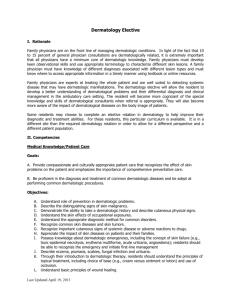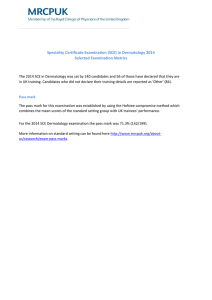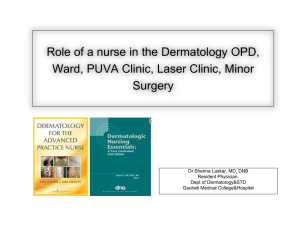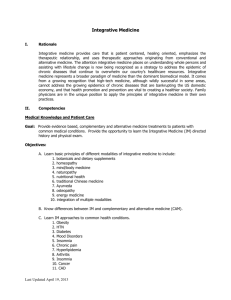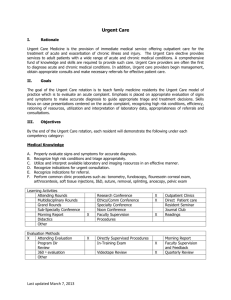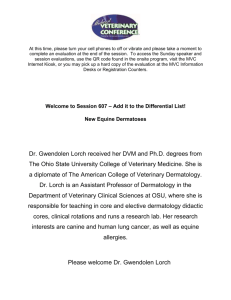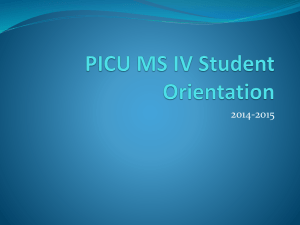Dermatology - Department of Family & Preventive Medicine
advertisement
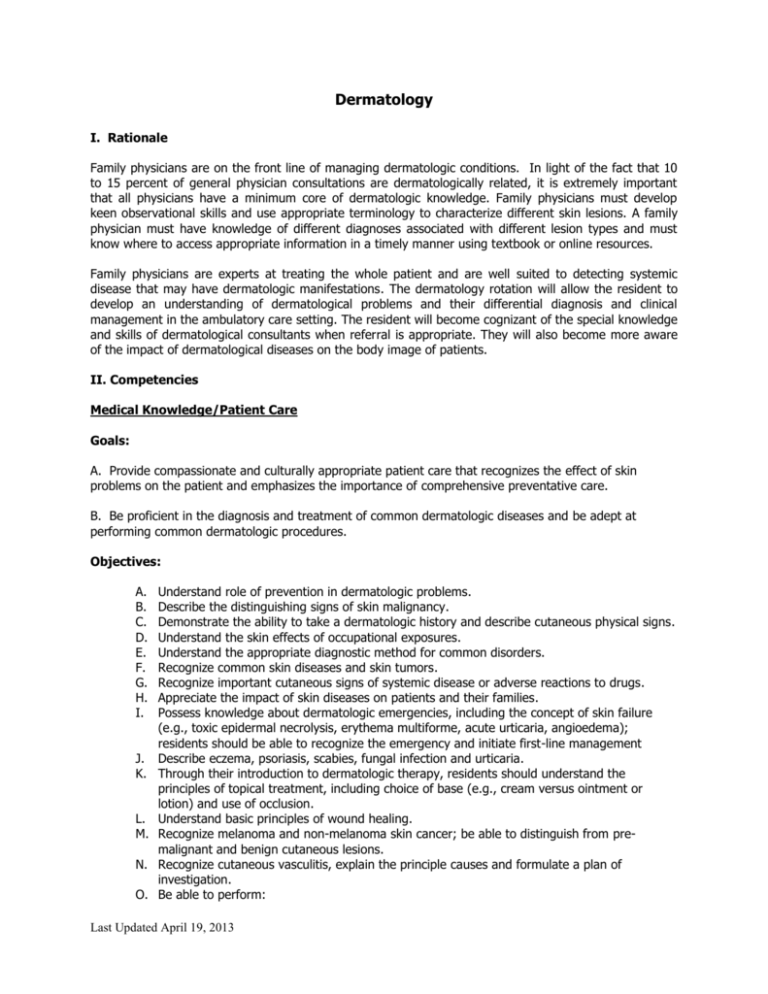
Dermatology I. Rationale Family physicians are on the front line of managing dermatologic conditions. In light of the fact that 10 to 15 percent of general physician consultations are dermatologically related, it is extremely important that all physicians have a minimum core of dermatologic knowledge. Family physicians must develop keen observational skills and use appropriate terminology to characterize different skin lesions. A family physician must have knowledge of different diagnoses associated with different lesion types and must know where to access appropriate information in a timely manner using textbook or online resources. Family physicians are experts at treating the whole patient and are well suited to detecting systemic disease that may have dermatologic manifestations. The dermatology rotation will allow the resident to develop an understanding of dermatological problems and their differential diagnosis and clinical management in the ambulatory care setting. The resident will become cognizant of the special knowledge and skills of dermatological consultants when referral is appropriate. They will also become more aware of the impact of dermatological diseases on the body image of patients. II. Competencies Medical Knowledge/Patient Care Goals: A. Provide compassionate and culturally appropriate patient care that recognizes the effect of skin problems on the patient and emphasizes the importance of comprehensive preventative care. B. Be proficient in the diagnosis and treatment of common dermatologic diseases and be adept at performing common dermatologic procedures. Objectives: A. B. C. D. E. F. G. H. I. J. K. L. M. N. O. Understand role of prevention in dermatologic problems. Describe the distinguishing signs of skin malignancy. Demonstrate the ability to take a dermatologic history and describe cutaneous physical signs. Understand the skin effects of occupational exposures. Understand the appropriate diagnostic method for common disorders. Recognize common skin diseases and skin tumors. Recognize important cutaneous signs of systemic disease or adverse reactions to drugs. Appreciate the impact of skin diseases on patients and their families. Possess knowledge about dermatologic emergencies, including the concept of skin failure (e.g., toxic epidermal necrolysis, erythema multiforme, acute urticaria, angioedema); residents should be able to recognize the emergency and initiate first-line management Describe eczema, psoriasis, scabies, fungal infection and urticaria. Through their introduction to dermatologic therapy, residents should understand the principles of topical treatment, including choice of base (e.g., cream versus ointment or lotion) and use of occlusion. Understand basic principles of wound healing. Recognize melanoma and non-melanoma skin cancer; be able to distinguish from premalignant and benign cutaneous lesions. Recognize cutaneous vasculitis, explain the principle causes and formulate a plan of investigation. Be able to perform: Last Updated April 19, 2013 1. Biopsy of skin lesions (punch biopsy, shave biopsy, excisional biopsy) 2. Scraping and microscopic examination 3. Injection (local anesthesia, steroids) 4. Incision and drainage 5. Destruction of lesions (cryosurgery, electrodesiccation, curettage) P. Write a prescription for topical treatment that reflects knowledge of quantities and bases. Q. Diagnosis, differential diagnosis, management and prevention of: 1. Inflammatory skin disease (atopic and contact dermatitis, psoriasis) 2. Skin cancer (melanoma, basal cell carcinoma, squamous cell carcinoma) 3. Acne 4. Leg ulcers 5. Cutaneous infections (bacterial, viral and fungal) 6. Infestations (e.g., scabies) 7. Urticaria 8. Blister disorders 9. Drug eruption Learning Activities X Attending Rounds X Multidisciplinary Rounds Grand Rounds Sub-Specialty Conference Morning Report X Didactics Other Evaluation Methods X Attending Evaluation Program Dir X Review X 360 ᵒ evaluation Other X X X Research Conference Ethics/Comm Conference Specialty Conference Noon Conference Faculty Supervision Procedures X X X Directly Supervised Procedures In-Training Exam X Videotape Review X X Outpatient Clinics Direct Patient care Resident Seminar Journal Club Readings Morning Report Faculty Supervision and Feedback Quarterly Review Interpersonal and Communication Skills Goal: Demonstrate the ability to communicate effectively with the patient so that dermatologic diagnosis and treatment is provided in a non-judgmental, caring manner. Objectives: A. Understand the impact of skin problems on patients and their families. B. Develop skills for interviewing that allow accurate, complete collection of information regarding symptoms, family, and community environment that affect the patient. C. Develop skills in communicating results, educating patients and their families, dealing with sensitive issues for patients and families, and negotiating a plan of treatment with the patient and family. D. Develop counseling skills appropriate for prevention and management of skin problems. Last Updated April 19, 2013 Learning Activities Attending Rounds Multidisciplinary Rounds Grand Rounds Sub-Specialty Conference X Morning Report Didactics Other Evaluation Methods X Attending Evaluation Program Dir X Review X 360 ᵒ evaluation Other X X X Research Conference Ethics/Comm Conference Specialty Conference Noon Conference Faculty Supervision Procedures X X X Directly Supervised Procedures In-Training Exam X Videotape Review X Outpatient Clinics Direct Patient care Resident Seminar Journal Club Readings Morning Report Faculty Supervision and Feedback Quarterly Review Practice Based Learning and Improvement Goal: Utilize diagnostic and evidence-based treatment guidelines as well as maintain up to date knowledge of appropriate usage of evolving dermatologic treatment technology. Objectives: A. Identify resources for personal education and develop a plan for ongoing education in dermatology. B. Identify Point of Care learning resources. C. Utilize Electronic Medical Records Decision aid tools and templates for patient care. D. Recognizes strengths and weaknesses of knowledge and skills in self and others. E. Appropriately code for procedures done. F. Document all procedures performed and the diagnoses of patients managed. Learning Activities Attending Rounds Multidisciplinary Rounds Grand Rounds Sub-Specialty Conference Morning Report X Didactics Other Evaluation Methods X Attending Evaluation X Program Dir Review 360 ᵒ evaluation Other Last Updated April 19, 2013 X X Research Conference Ethics/Comm Conference Specialty Conference Noon Conference Faculty Supervision Procedures X X X Directly Supervised Procedures In-Training Exam X Videotape Review X Outpatient Clinics Direct Patient care Resident Seminar Journal Club Readings Morning Report Faculty Supervision and Feedback Quarterly Review Systems Based Practice Goal: Incorporate knowledge of the dermatology specialty in order to determine which problems can be managed by a family physician and to understand how to coordinate needed referrals to specialty providers. Objectives: A. Utilize and understand the importance of appropriate referral or consultation with dermatologists. B. Distinguish between primary management of skin disorders and appropriate referral. C. Support of the individual and family through consultation, evaluation and treatment. D. Understand the psychosocial and economic impact of dermatological disease on the individual and family and use of the health care system to assist as needed. E. Learns most cost effective ways to manage dermatological conditions. Learning Activities Attending Rounds X Multidisciplinary Rounds Grand Rounds Sub-Specialty Conference Morning Report Didactics Other Evaluation Methods X Attending Evaluation X Program Dir Review X 360 ᵒ evaluation Other X Research Conference X Outpatient Clinics Ethics/Comm Conference Specialty Conference Noon Conference Faculty Supervision Procedures X Direct Patient care Resident Seminar Journal Club Readings Directly Supervised Procedures In-Training Exam X X Videotape Review Morning Report Faculty Supervision and Feedback Quarterly Review Professionalism Goal: Residents will demonstrate a commitment to carrying out professional responsibilities, adherence to ethical principles, and sensitivity to a diverse patient population. Objectives: A. Demonstrate integrity, honesty, respect and a commitment to excellence in all activities. B. Demonstrate sensitivity, respect and adapt appropriately to the social and cultural issues of each patient. C. Display initiative and resourcefulness in patient care and in solving problems. D. Be timely in attendance of activities and completion of tasks. Learning Activities Attending Rounds Multidisciplinary Rounds Last Updated April 19, 2013 Research Conference Ethics/Comm Conference X X Outpatient Clinics Direct Patient care Grand Rounds Sub-Specialty Conference Morning Report Didactics Other: Evaluation Methods X Attending Evaluation X Program Dir Review X 360 ᵒ evaluation Other X X Specialty Conference Noon Conference Faculty Supervision Procedures Resident Seminar Journal Club Readings Directly Supervised Procedures In-Training Exam X Videotape Review X Morning Report Faculty Supervision and Feedback Quarterly Review III. Instructional Strategies (see above) This will be 1-month block rotation taught mostly through precepted patient care under the supervision of both dermatologists and family physicians. These will be complemented by didactic presentations on a longitudinal basis. A. B. C. D. E. Direct patient care of dermatology patients Teaching during patient rounds Dermatology lectures / conferences Independent reading Procedural learning IV. Evaluation Strategies (see above) A. Resident Evaluation: 1. The resident will receive a final evaluation 2. At the midpoint of each rotation (as a minimum) and frequently as possible throughout, the resident should be given specific and instructive feedback in progress to include recommendations for improvement and personal growth. If the resident does not receive this midpoint evaluation, he/she should request it from the Dermatology preceptor. B. Rotation Evaluation: 1. The resident will provide written and verbal feedback to the Derm staff and to the FP advisor at the end of the rotation. 2. C. If the resident finds that the rotation is not meeting stated objectives, both the Derm staff and the FP liaison must be notified. This will allow time for corrections of deficiencies. Other Dermatology Evaluations: The resident's ability to deal with clinical dermatology will be assessed by the: 1. Rotation Evaluation 2. FP Clinic Chart Audits 3. FP In-service Training Exam 4. Observation of the resident in the FP Clinic will staff feedback Last Updated April 19, 2013 V. Implementation Methods A. Administrative Policies: 1. Length of rotation: 1 month 2. Location: Dermatology Clinic & Grady Memorial Hospital 3. Leave Policy: One-week allowed B. Dermatology Liaison: Sareeta Parker, MD Grady Memorial Hospital 80 Jesse Hill Jr. Drive Atlanta, GA 30303 Connie Kearse – Contact Person (404) 727-5106 (404) 616-4239 C. Resident Responsibilities: 1. The resident interviews and examines clinic patients with a focused dermatologic exam. The resident presents the case, the differential, and the treatment plan to the dermatologist. The preceptor will examine the patient and add teaching points for each case. The resident works at his/her own pace. 2. Procedures are learned in the Derm clinic. The resident will be allowed to work independently, after demonstrating technical competence in each procedure: shave biopsy, excisional biopsy, cryotherapy, intralesional injection. 3. Spend 6 half-days per week in dermatology clinic and 4 half-days per week in Family Practice Clinic. 4. Attend morning dermatologic conference on mornings when not in the Family Practice Clinic. 5. Attend Family Practice morning report on mornings when in Family Practice Clinic. 6. Take Family Practice call. 7. Document all procedures and diagnoses managed 8. Actively seek feedback from preceptors. VI. Suggested Readings/Resources Clinical Dermatology: A Color Guide to Diagnosis and Therapy by Habif. This may be supplemented on an as-needed basis by articles suggested by the dermatology preceptor. Weinstock M, et al. Basic Skin Cancer Triage for Teaching Melanoma Detection. Journal of the American Academy of Dermatology. 34(6):1063-11)66, 1996 Anonymous. Conditions of the Skin: Recommended Core Educational Guideline for Family Practice Residents. American Family Physician. 49(5):1253-1,'),56, 1994 O'Brien J. Common Skin Problems of Infancy, Childhood, and Adolescence. Primary Car @, 22(l):99-115, 1995 Fleischer A, Feldman S, McConnell C. The Most Common Dermatologic Problems Identified by Family Physicians, 1990-1994. Family Medicine, 29i,9):648-652, 1997. Last Updated April 19, 2013 Online Resources American Academy of Dermatology http://www.aad.org/education-and-quality-care/medicalstudent-core-curriculum : Online core curriculum for dermatology http://emedicine.medscape.com/article/1130419-overview#aw2aab6b4: Extremely comprehensive and updated list of Dermatology sites. Electronic Textbook of Dermatology: http://www.telemedicine.org/stamford.htm Image Databases Dermatlas: http://dermatlas.med.jhmi.edu/derm Dermatologic Image Database: The University of Iowa College of Medicine's Department of Dermatology includes many excellent low-resolution images. Dermatology Internet Service (DermIS): http://www.dermis.net/dermisroot/en/home/index.htm American Osteopathic College of Dermatology http://www.aocd.org AFP Monographs Skin Disorders Update (#346) March 2008 Last Updated April 19, 2013
